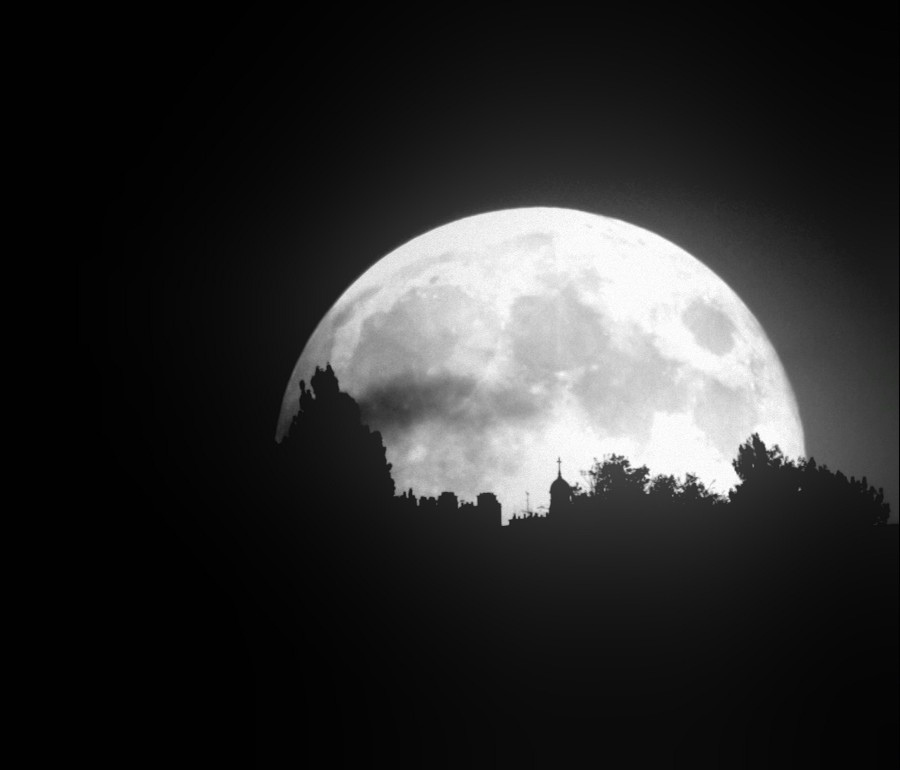Blue Moon Rises Tonight: 5 Amazing Facts

UPDATE: The first photos are in for August's full moon! Read some of the reactions from the stargazers behind the photos: Blue Moon Majesty Wows Stargazers (Photos )
When the full moon rises tonight (Aug. 20), it will technically be a Blue Moon, but not for the reason you might think.
The Blue Moon tonight is not the second full moon of August, but actually gets its name from a relatively obscure rule of astronomy. And there are a few other details about the full moon that might surprise you.
So to celebrate the Blue Moon, here are five amazing facts about this month's full moon:
1) It's not really blue: Okay, so not really a newsflash, but the Blue Moon's name actually has nothing to do with color. Occasionally, the full moon can take on a reddish pallor, but today's full moon is not related to the actual color of Earth's cosmic neighbor. The moon can appear blue in color if a forest fire or volcanic eruption litters the upper atmosphere with ash or smoke. A volcanic eruption gave the moon a bluish tint from the perspective of many people on Earth in 1991. [Blue Moon Explained (Infographic)]
2) There are two definitions for Blue Moon: The term Blue Moon was originally assigned to the third full moon in a four moon season, but after a mix up in "Sky & Telescope" magazine in 1946, the term took on a different meaning. An article in the magazine incorrectly defined a blue moon as the second full moon in a single month, but the definition stuck. This particular blue moon is a technical Blue Moon, but does not meet the criteria for the second definition. The third full moon in a four-full-moon season rule was detailed in a 1937 edition of the now defunct Maine Farmers' Almanac.
3) The Blue Moon has many names: Today's full moon is also known as the Full Sturgeon Moon, the Green Corn Moon, the Grain Moon and the Full Red Moon. Each of August full moon names come from monikers given to the full moons of a certain month according to Native American and European traditions.
Breaking space news, the latest updates on rocket launches, skywatching events and more!
4) It's only full for a moment: Although the moon usually looks full one day before and one day after the day of the full moon, there is technically only one moment when the moon is full in the sky. Tonight, the moon turns full at 9:45 p.m. EDT (0145 Aug. 21 GMT), when (weather and light permitting) the moon will be in view for people along the eastern coast of the United States.
5) It's kind of a rare sight: Blue Moons occur somewhat infrequently. After today's full moon, another Blue Moon will not occur again until 2015. The idiom "once in a Blue Moon" signifies a rare event because scientists had trouble predicting when the distinctive full moon would happen during any given year.
Editor's note: If you have an amazing photo of the August full moon, or any other night sky sight, and you'd like to share it for a possible story or image gallery, please contact managing editor Tariq Malik at spacephotos@space.com.
This story was updated on Aug. 21 at 12:15 p.m. EDT (1615 GMT) to reflect a correction. The "Sky and Telescope" magazine article was published in 1946, not 1943 as stated in an earlier version of the story.
Follow Miriam Kramer @mirikramer and Google+. Follow us @Spacedotcom, Facebook and Google+. Original article on SPACE.com.

Miriam Kramer joined Space.com as a Staff Writer in December 2012. Since then, she has floated in weightlessness on a zero-gravity flight, felt the pull of 4-Gs in a trainer aircraft and watched rockets soar into space from Florida and Virginia. She also served as Space.com's lead space entertainment reporter, and enjoys all aspects of space news, astronomy and commercial spaceflight. Miriam has also presented space stories during live interviews with Fox News and other TV and radio outlets. She originally hails from Knoxville, Tennessee where she and her family would take trips to dark spots on the outskirts of town to watch meteor showers every year. She loves to travel and one day hopes to see the northern lights in person. Miriam is currently a space reporter with Axios, writing the Axios Space newsletter. You can follow Miriam on Twitter.
![Thought to be called "blue" after an old english term meaning "betrayer," a Blue Moon is an extra full moon that occurs due to a quirk of the calendar. [See the full Blue Moon Infographic here.]](https://cdn.mos.cms.futurecdn.net/HHbm7kUWUR8zaAccXs7kqg.jpg)
